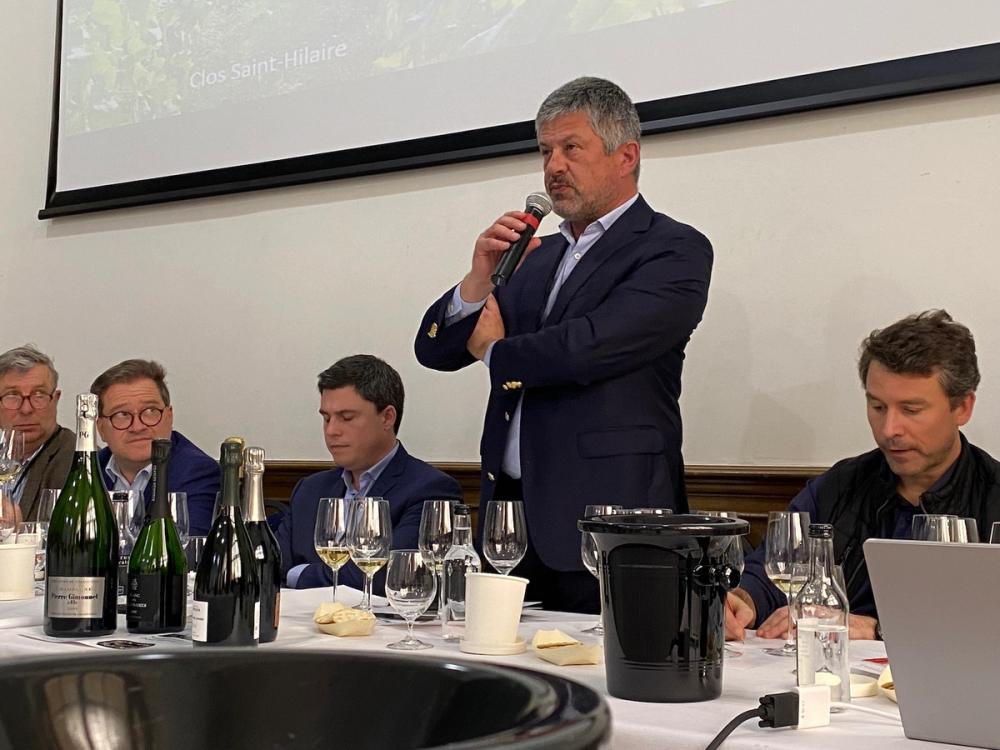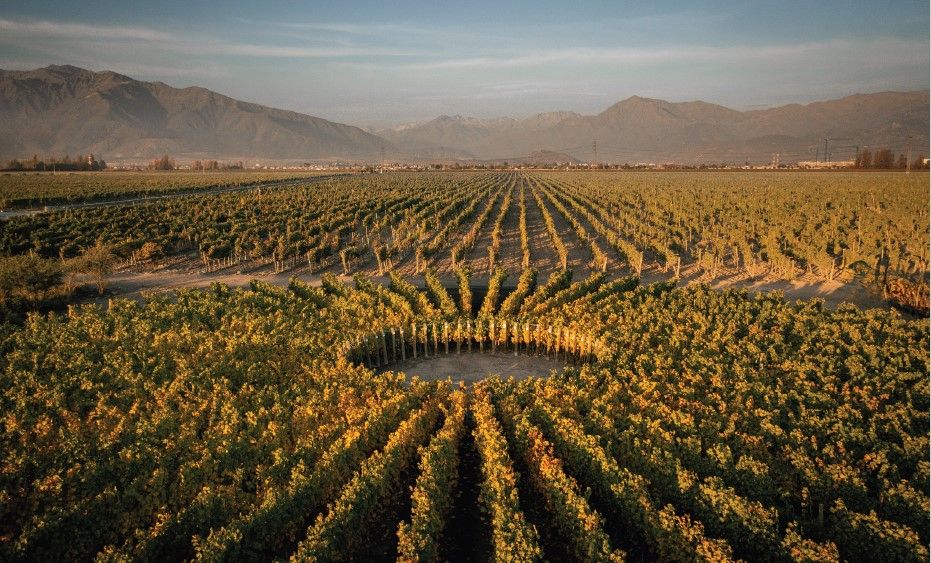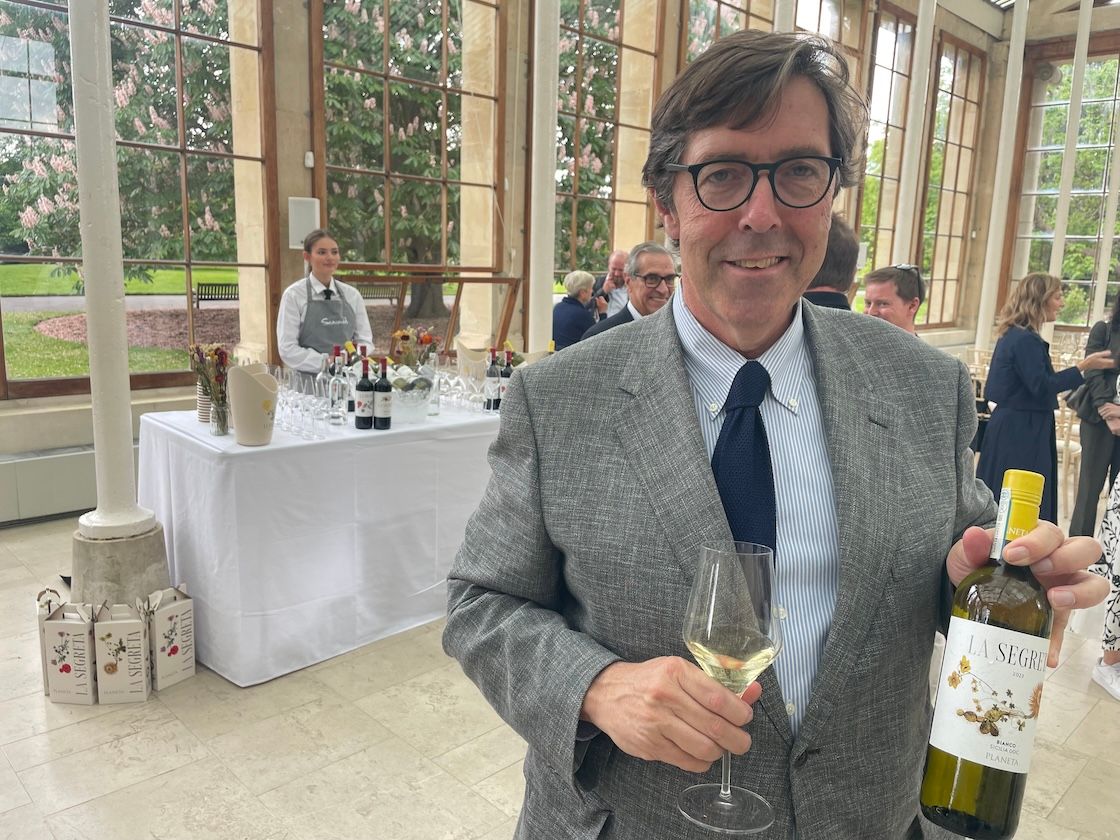“A lot of biodynamic vineyards yielded zero in 2016 and 2017…we are not looking to certify, it is important to keep a hand on the production,” says Antoine Roland-Billecart
The Taste Champagne 2022 event last week in London showed 327 cuvées from 63 Champagne négociants, cooperatives and growers to trade and press and, in the evening, to paying consumers. Fronted by Tyson Stelzer and managed by Jody Rolfe the event focused on the key underperforming categories in the UK market –prestige cuvées, growers and rosés.
House-specific masterclasses took place throughout the day, kicked off by one focusing on Sustainability. Five of Champagne’s key movers and shakers were on the panel of this event hosted by Stelzer.

The Sustainability panel: Didier Gimonnet, Cyril Brun, Thomas Jorez, Antoine Roland-Billecart and Denis Bunner (l-r)
Didier Gimonnet, managing director of Pierre Gimmonnet & Fils, Cyril Brun, chef de cave, Charles Heidsieck, Thomas Jorez, export director for Philipponnat, Antoine Roland-Billecart, deputy general manager Billecart-Salmon and Denis Bunner, deputy chef de cave, Bollinger took it in turns to give a quick update on what their House was doing in the way of initiatives in sustainability. This was accompanied by each showing their top cuvées to showcase the impact of this work.
The sustainable objectives Champagne have set themselves as a region are ambitious to say the least: to aim to reduce carbon footprint 75% by 2050; to totally eliminate the use of herbicide in three years’ time and for the entire region to be fully environmentally certified by 2030. Currently just 20% of the region has those certificates in place with carbon footprint on a bottle of Champagne reduced by 20% over the past 15 years, a time period that has also seen significant strides in the treatment and recycling of industrial waste and wine production effluents, and the use of phytosanitary products and nitrogen fertilizers halved.
Given the 45-minute running time the masterclass focused on Sustainable viticulture only which loosely translates as the grower avoiding the use of products that can be hazardous to the environment and people but, in the case of an emergency, can make use of synthetic chemical products.
Like many growers and Houses in Champagne the panel members believe in working organically and sometimes biodynamically but without seeking certification to uphold the flexibility to intervene when rot looks like setting in.

Tyson Stelzer (r) introducing the session
So how have our panelists been faring?
Didier Gimonnet, managing director of Pierre Gimonnet & Fils explained that the two most important things for his House currently is sustainable viticulture but also the use of old vines, rather than strive for organic certification. Gimonnet starts each growing season with organic farming and, as the season develops, takes a view based upon the conditions, prioritising saving the crop at the same time as respecting the health of the soil. Gimonnet stopped using herbicide 10 years ago, use no insecticides to encourage deeper root growth and minimise the use of phytosanitary products. Of its 30 hectares of vineyard, 13 are Grand Cru and 17 Premier Cru and, of the Grand Cru, 80% are vines that are over 50 years old which he says is the best way of naturally containing yield which averages 11-12 tons per hectare when 18-20 is the potential yield.
Cyril Brun, Chef de cave, Charles Heidsieck also favours a flexible and pragmatic approach, although in his case Charles Heidsieck does have Victiculture Durable en Champagne (VDC) and High Environmental Value (HEV) certification and encourages all his grape suppliers to follow the same policy. “At the very least sustainability is a good excuse to come back to details,” he says, “We need to be globally more flexible in everything we do. The Champenois can be perceived to be quite arrogant but we need to have our two feet on the ground to redefine what is Champagne.”

Thomas Jorez, export director for Philipponnat explained that at certain stages of the growing season when vignerons had to cope with mildew, the challenge was whether to stick with organic products or abandon them. Biodynamic products help the vines with mildew which means a reduction of sulphur, “but one of the challenges with organic products is how to protect the vineyard from mildew especially around flowering time when the quantity of grapes you are going to get is determined.” Jorez said that although they use essential oils at flowering time copper sulphate is also used, depending upon how the growing season is rolling out.
Since 2000 Philipponnat has abolished pesticides and herbicides, tending its 20 hectares with natural methods, hoeing by hand and ploughing with horses. The House gained HEV in 2013 and VDC in 2015 but when Charles Philipponnat decided to go fully organic “heavy rain showers made us go backwards, it was too much of a risk. We focus on healthy grapes and also saving the harvest but we do go further step by step every year according to the weather.”
Antoine Roland-Billecart, deputy general manager of Billecart-Salmon described how the House is moving towards full biodynamic viticulture – but at a pace. The wine he showed the Le Clos Saint-Hilaire 2006 comes from a vineyard that has been fully biodynamically-farmed for the past 14 years with another five hectares of the estate’s 100 hectares (the House sources from 200 hectares of growers) also farmed this way. They do not seek certification so they can have flexibility “A lot of biodynamic vineyards yielded zero in 2016 and 2017…we are not looking to certify, it is important to keep a hand on the production” he said. Certified CVD and HEV, the House has eliminated pesticides and herbicides and is using only natural fungicides. Strict pruning regimes are employed to ‘drive the wines’ – limiting the yield and increasing the concentration and aromatic components.
Denis Bunner, deputy chef de cave, Bollinger stressed that his House was determined to be at the forefront of sustainable viticulture, having been the first House to be certified HEV (2012) and VDC (2014) in Champagne. Again, Bollinger is not aspiring to have certification in organics even though it is experimenting with it in a number of its plots. “I don’t care about being organic,” he said, “but I am very interested in the soil and in the ferments.” Bollinger advocates a ‘less is more’ approach with a clear global definition of sustainability being employed. For example, by 2014 it measured a reduction in carbon footprint per bottle of 20% which was partly down to two electric tractors it purchased in 2006 and also its reliance on manpower – Bollinger allocates 500-man hours per hectare each year to manage its 180 hectares compared to a regional average of 380 hours. Bollinger only uses natural cork for secondary fermentation, all disgorgement is done by hand, and it now co-inoculates so that the malolactic fermentation is started by the heat of the fermentation – rather than waiting, as they did previously, and heating the winery to initiate malo.
By 2015 Bollinger was 95% herbicide and is now 100% free. In tasting the La Grande Année 2014 he believes that you can feel the purity of the viticulture on the palate and, with vinifying ion 20-year-old barrels there’s a precision that links well to the terroir and its quality. “It’s a perfect example of the purity… you can really feel it on the palate,” he says.

The five cuvées tasted during the masterclass
In conclusion…
Stelzer prefaced this discussion by saying that it was not an academic discussion and clearly it was the roughest of snapshots. To spend 45 minutes with five of the region’s most influential figures and tasting five outstanding cuvées will never be enough time for a deep dive into Sustainability; the cuvées that were highlighting the impact of their work in the vineyard – 2006, 2007, 2008, 2010 and 2014 – predated much of the work undertaken (Bollinger was the first House to be certified HEV and VDC – and that was as most recently as 2012 and 2014 respectively); and Sustainability itself seemed to be too narrowly defined.
Having said that, Champagne as a region has been revolutionised over the past two decades and no French wine region has needed viticultural change more desperately. Sacrificing long-term vine and soil health in favour of high yields will hopefully be a thing of the past and clearly great strides are being made in this regard. Next year it will be useful to have more of an in-depth discussion that includes a broader definition of Sustainability – breaking the discussion down to look at carbon, water and biodiversity footprints and looking at data to see how the region as a whole is performing in order to reach its ambitious target of total environmental certification by 2030.






































